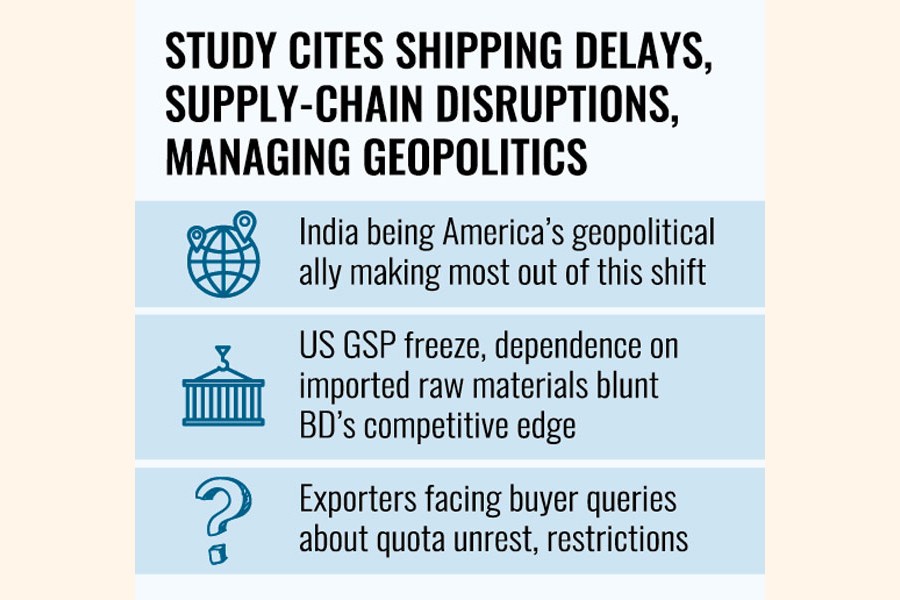
US cos shifting from BD in apparel sourcing
MONIRA MUNNI | Wednesday, 31 July 2024

American fashion companies are actively diversifying their apparel- sourcing base and exploring opportunities especially in India amid growing risks and market uncertainty in Bangladesh, says a latest US study.
It cites shipping delays and supply-chain disruptions and 'managing geopolitics and other political instability' related to sourcing which have newly emerged among US brands and retailers as top five concerns in 2024.
They consider India as more competitive than most other Asian suppliers regarding vertical-integration capability, manufacturing flexibility, and agility.
"While China (100-percent utilization rate) and Vietnam (89-percent utilization rate) still lead, for the first time since 2014 we conducted the survey, more respondents reported sourcing from India (89-percent utilization rate) than from Bangladesh (86 per cent utilization rate)," reads the report.
India in 2024 ranked second from fourth in 2023 while Bangladesh ranked down to fourth position from third last year.
Titled '2024 Fashion Industry Benchmarking Study', the study report also reveals that nearly 60 percent of respondents plan to expand apparel sourcing from India over the next two years, exceeding the planned expansion from any other Asian country.
By leveraging its more advanced local textile-manufacturing capability, India's apparel exports to the United States relied much less on imported components than economically developed countries such as Bangladesh, Cambodia, and Vietnam, according to the report.
Additionally, as India is elevated as a strategic partner with the United States, sourcing from there "is perceived as involving relatively lower geopolitical risks".
On the other hand, about 48 per cent of respondents expressed an interest in expanding apparel sourcing from Bangladesh over the next two years, down from 52 per cent in 2023 and 58 per cent in 2022.
"The high social-compliance risks involved in sourcing from the country remained a key concern for respondents."
Citing example, it says the high-profile labour protests over the minimum wage increase in late 2023 brought Bangladesh's social- responsibility record in the garment sector back into the news headlines.
The report has quoted one respondent as commenting, "We monitor the situation closely. Meanwhile, as an apparel-sourcing base, Bangladesh is well-known for its price competitiveness. However, the country's export potential has been constrained by its limited product diversification beyond basic cotton items and knitwear."
Findings of the eleventh edition of the survey, jointly conducted by the United States Fashion Industry Association (USFIA) and the University of Delaware, were released Monday.
It surveyed executives from 30 leading fashion brands, retailers, importers, and wholesalers, including some of the largest brands and retailers in the country, from April to June 2024.
The report shows that a higher percentage of respondents sourced from Cambodia and Indonesia (each 75 per cent utilization rate) and Pakistan (61 per cent utilization rate) this year, with the gaps in their utilization rates compared to the top tier significantly narrowing.
"The results reveal that US fashion companies have been diversifying their sourcing base beyond China, Vietnam, and Bangladesh, even though companies are not necessarily leaving Asia."
In comparison, almost all respondents, 97 per cent, to be specific, say at least 40 per cent of their total sourcing value or volume now comes from Asian countries other than China.
Specifically, respondents commonly placed about 11-30 percent of their sourcing orders in large-scale apparel-supplying countries such as Vietnam, Bangladesh, and India.
Limited by manufacturing capability, other smaller-scale Asian countries such as Cambodia, Indonesia, and Pakistan typically accounted for 1-10 percent of a fashion companies' total sourcing value or volume.
Asked about the buyer shift, Fazlul Hoque, former president of Bangladesh Knitwear Manufacturers and Exporters Association (BKMEA), said it is concerning that Bangladesh is losing business to its competitors like China, Vietnam, India and Pakistan mainly because of high cost of production fuelled by high utility charges with severe shortage of energy, especially gas.
"Bangladesh competes only offering competitive prices whereas its competitors like China, India and Pakistan offer lowest price aggressively as they have their own raw materials," he said.
Local industry is facing high cost due to high gas and electricity prices while there is no adequate supply of energy while wages have been increased and interest rate goes up. All these erode their competitive edges.
"Even there is no prediction that the situation might improve and we have no options to minimize costs," he said, adding that situation is getting worse during last one year.
Another exporter says US big buyers are interconnected with their political parties and geopolitics matter in their sourcing patterns. And Bangladesh gets no duty benefit there.
Both the exporters expressed concern over the ongoing situation as they are getting queries from buyers over the present situation marked by anti-quota movement and violence-taming curfew.
Official figures from the Office of Textiles and Apparel (OTEXA) show that Bangladesh's readymade garment (RMG) exports to the US totalled $7.28 billion in 2023 in a 25.07-percent drop compared to the $9.72 billion earned in 2022.
Data showed that 2022 apparel earnings were almost double the 2013 earnings of $4.94 billion when the USA suspended its GSP facility for Bangladesh-made exportable goods on grounds of poor labour and safety standards immediately after the Rana Plaza building collapse.
Local RMG, however, does not enjoy the US GSP facility.
Bangladesh shipped clothing items worth $7.13 billion during January-December 2021, according to OTEXA data.
Bangladesh's apparel exports to the United States sustained a double-digit decline of 12.31 per cent in the first five months of 2024, reaching $2.90 billion.
On the other hand, India witnessed a 2.06-percent negative growth to earn US$2.08 billion during January-May period of 2024. Similarly, US apparel imports from India in 2023 had experienced negative growth of 21.42 per cent, reaching $4.46 billion. The figure was $5.69 billion in 2022, according to OTEXA data.
Munni_fe@yahoo.com